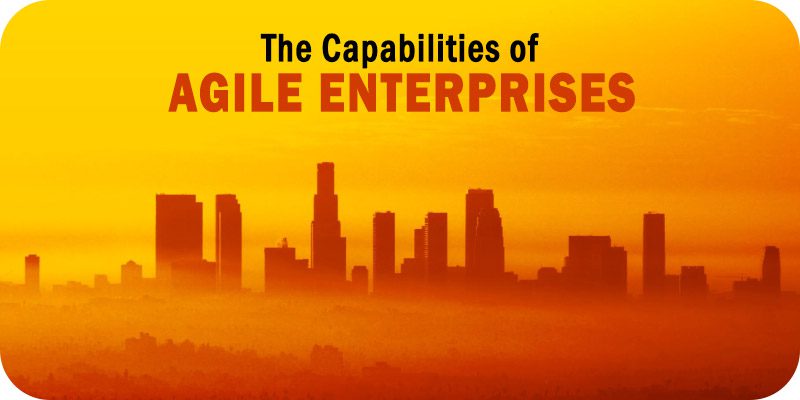The Capabilities of Agile Enterprises Today


As part of Solutions Review’s Expert Insights Series—a collection of contributed articles written by industry experts in enterprise software categories—Nishant Patel, the Co-Founder and CTO of Contentstack, outlines the capabilities that today’s agile enterprises should continue to prioritize.
 It’s easy to look at agility as just another corporate buzzword. Pushing past the fluff of the word, agility is more relevant than ever for enterprises. A 2021 McKinsey survey revealed that enterprise transformations focusing on agility dramatically improved business performance, but it wasn’t an effortless, organic achievement. Concerted leadership effort and investment are required to be successful—there’s a mindset shift that needs to happen.
It’s easy to look at agility as just another corporate buzzword. Pushing past the fluff of the word, agility is more relevant than ever for enterprises. A 2021 McKinsey survey revealed that enterprise transformations focusing on agility dramatically improved business performance, but it wasn’t an effortless, organic achievement. Concerted leadership effort and investment are required to be successful—there’s a mindset shift that needs to happen.
Technology moves forward quickly now, and solutions are becoming more plentiful. Agile enterprises need to be open to change and the right solutions instead of going back to the same tools and vendors expecting better results than they yielded before. They also need to support and empower their people along the way. Agility is a journey, not a destination. You’ll encounter new ideas and solutions for every problem along the way. However, there are certain core elements agile enterprises should have.
Cloud
The ability to pivot quickly requires reducing your institutional momentum as much as possible. Cloud eliminates the significant capital outlays and months or years of planning of traditional IT infrastructure. Many major cloud providers will charge you only for the capacity that you use and allow you to change that capacity on the fly to adjust for variable workloads. Cloud infrastructure can reduce costs by almost 30 percent, and you can convert capex to opex, allowing more flexible spending.
If the cloud is something you’ve already invested in—which many of us have—here is something else to consider: are you getting the value you need? You can be in the cloud and still suffer from the poor architecture on the back end, leading to outages, cost run-ups, and security breaches that aren’t easily solvable. Invest in reliably-constructed cloud solutions and the best talent and tech to support the entire stack. Flexibility, productivity, and scalability will follow.
Single Sign-On (SSO) and Cybersecurity
Password management has been and will continue to be a severe security problem. How many times have you heard people say that they have just a few passwords that they use for everything? How many hundreds of accounts do you need to manage?
SSO solutions simplify security by enabling users to log in once per session for a group of applications rather than requiring an account for each program. Several types of SSO are common today. The advantage is reducing the tangled web of logins for disparate applications to a single account that works, in some cases, across the entire organization, on-premises or off. Less juggling of user accounts leaves less room for error and makes interacting with company systems faster and easier. However, since SSO relies on a single login for multiple applications, you should ensure that your organization has good password policies. (Here is the obligatory XKCD reference regarding password strength.)
Speaking of security, organizations can no longer afford to treat cybersecurity as an afterthought. With so many moving pieces and interconnected systems, security needs to be built in as much as possible rather than added later. Investing in top-notch cybersecurity solutions will protect and reinforce your cloud investments and ensure that organizations can protect themselves against an emerging risks, new or not.
Tool Management
As I explained in another article, enterprises pay for an astonishing number of apps—364, according to Productiv—but use less than half of them regularly. Spending resources on shadow IT and underused apps can seriously drain your company and hamper your agility.
Naturally, there’s an app for that. If you want to streamline the apps you use, you could go through them manually, like I described in my earlier piece, or you could use a tool like Zluri, which lets you manage your enterprise apps from a centralized dashboard. Don’t let tools that are supposed to help hinder the organization.
Efficiency and Innovation
Innovative organizations are already beginning to incorporate the next generation of agile technologies, but these haven’t hit the majority yet. As you consider the future, look forward to many AI tools that will bring more capabilities, especially for content generation, video, and images. Evaluate the ROI of emerging technologies— does it fit your teams?
At Contentstack, we measure our engineering sprints and development through LinearB to maximize efficiency. The tool helps us identify inefficiencies in our processes, see if we’re delivering on our goals, and automates tasks like reviews. When using it for our cloud side, my mantra is, “Can we get maximum scale with minimum costs and no degradation in quality?” We measure and look for opportunities to increase efficiency whenever possible, which frees up room for more innovation.
Agility is a defining characteristic of organizations that are future-proofed for today’s dynamic market environment. Remember, it is a journey, not a destination. Wherever you are on your agile journey, keep going. Continue building your organization’s core stability while investing in current and emerging technologies that keep you light on your feet.




















